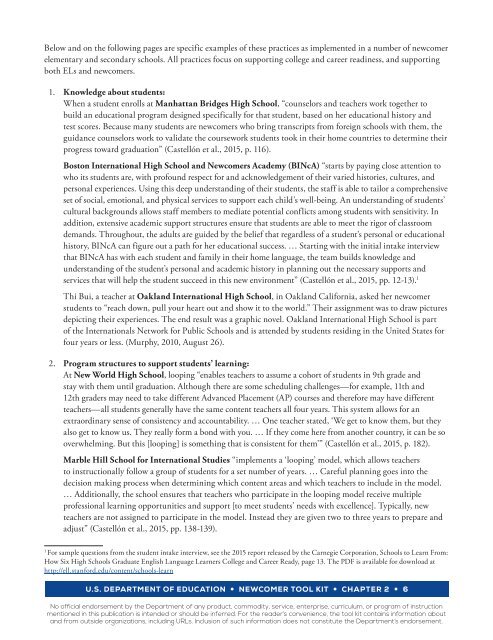NEWCOMER TOOL KIT
xYhe4
xYhe4
You also want an ePaper? Increase the reach of your titles
YUMPU automatically turns print PDFs into web optimized ePapers that Google loves.
Below and on the following pages are specific examples of these practices as implemented in a number of newcomer<br />
elementary and secondary schools. All practices focus on supporting college and career readiness, and supporting<br />
both ELs and newcomers.<br />
1. Knowledge about students:<br />
When a student enrolls at Manhattan Bridges High School, “counselors and teachers work together to<br />
build an educational program designed specifically for that student, based on her educational history and<br />
test scores. Because many students are newcomers who bring transcripts from foreign schools with them, the<br />
guidance counselors work to validate the coursework students took in their home countries to determine their<br />
progress toward graduation” (Castellón et al., 2015, p. 116).<br />
Boston International High School and Newcomers Academy (BINcA) “starts by paying close attention to<br />
who its students are, with profound respect for and acknowledgement of their varied histories, cultures, and<br />
personal experiences. Using this deep understanding of their students, the staff is able to tailor a comprehensive<br />
set of social, emotional, and physical services to support each child’s well-being. An understanding of students’<br />
cultural backgrounds allows staff members to mediate potential conflicts among students with sensitivity. In<br />
addition, extensive academic support structures ensure that students are able to meet the rigor of classroom<br />
demands. Throughout, the adults are guided by the belief that regardless of a student’s personal or educational<br />
history, BINcA can figure out a path for her educational success. … Starting with the initial intake interview<br />
that BINcA has with each student and family in their home language, the team builds knowledge and<br />
understanding of the student’s personal and academic history in planning out the necessary supports and<br />
services that will help the student succeed in this new environment” (Castellón et al., 2015, pp. 12-13). 1<br />
Thi Bui, a teacher at Oakland International High School, in Oakland California, asked her newcomer<br />
students to “reach down, pull your heart out and show it to the world.” Their assignment was to draw pictures<br />
depicting their experiences. The end result was a graphic novel. Oakland International High School is part<br />
of the Internationals Network for Public Schools and is attended by students residing in the United States for<br />
four years or less. (Murphy, 2010, August 26).<br />
2. Program structures to support students’ learning:<br />
At New World High School, looping “enables teachers to assume a cohort of students in 9th grade and<br />
stay with them until graduation. Although there are some scheduling challenges—for example, 11th and<br />
12th graders may need to take different Advanced Placement (AP) courses and therefore may have different<br />
teachers—all students generally have the same content teachers all four years. This system allows for an<br />
extraordinary sense of consistency and accountability. … One teacher stated, ‘We get to know them, but they<br />
also get to know us. They really form a bond with you. … If they come here from another country, it can be so<br />
overwhelming. But this [looping] is something that is consistent for them’” (Castellón et al., 2015, p. 182).<br />
Marble Hill School for International Studies “implements a ‘looping’ model, which allows teachers<br />
to instructionally follow a group of students for a set number of years. … Careful planning goes into the<br />
decision making process when determining which content areas and which teachers to include in the model.<br />
… Additionally, the school ensures that teachers who participate in the looping model receive multiple<br />
professional learning opportunities and support [to meet students’ needs with excellence]. Typically, new<br />
teachers are not assigned to participate in the model. Instead they are given two to three years to prepare and<br />
adjust” (Castellón et al., 2015, pp. 138-139).<br />
1<br />
For sample questions from the student intake interview, see the 2015 report released by the Carnegie Corporation, Schools to Learn From:<br />
How Six High Schools Graduate English Language Learners College and Career Ready, page 13. The PDF is available for download at<br />
http://ell.stanford.edu/content/schools-learn<br />
U.S. DEPARTMENT OF EDUCATION • <strong>NEWCOMER</strong> <strong>TOOL</strong> <strong>KIT</strong> • CHAPTER 2 • 6<br />
No official endorsement by the Department of any product, commodity, service, enterprise, curriculum, or program of instruction<br />
mentioned in this publication is intended or should be inferred. For the reader’s convenience, the tool kit contains information about<br />
and from outside organizations, including URLs. Inclusion of such information does not constitute the Department’s endorsement.


